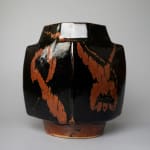Hamada Shoji 濱田庄司 1894-1978
H22.8 x Dia17.7 x Lip Dia 13.2cm
Further images
-
(View a larger image of thumbnail 1
)

-
(View a larger image of thumbnail 2
)

-
(View a larger image of thumbnail 3
)

-
(View a larger image of thumbnail 4
)

-
(View a larger image of thumbnail 5
)

-
(View a larger image of thumbnail 6
)

-
(View a larger image of thumbnail 7
)

-
(View a larger image of thumbnail 8
)

-
(View a larger image of thumbnail 9
)

-
(View a larger image of thumbnail 10
)

-
(View a larger image of thumbnail 11
)

-
(View a larger image of thumbnail 12
)

-
(View a larger image of thumbnail 13
)

Hamada Shoji was in the initial group of the first four ceramicists to be designated Living National Treasure in 1955, in his case for the preservation of mingei ceramics. Hamada needs little introduction as he, and Kawai Kanjiro, became the prime exponents of the mingei tradition that has been both popular and influential inside and outside Japan. Indeed, it is hard to look at post-1945 ceramics without seeing the influence they exerted. Nonetheless Hamada’s work remains significant and he is the true master of form and decoration. The myriad copies of his forms not only attest to his influence but also emphasize just what a master of proportion he was for there is a balance in his work and a harmony of form and decoration that sets it apart. The abstract decoration of black and brown glazes on the Jar in the exhibition exemplifies this. There is no doubt that it is his work from the 1940s but the colouration harks back to Northern Song-Jin Dynasty wares and reflects the depth of ceramic culture that Hamada drew upon.
Today, Hamada Shoji is recognized as one of the most important figures in the history of Japanese ceramics. His work is widely admired for its beauty, simplicity, and respect for traditional forms. For his contribution to the international pottery scene, he was awarded the title of a Living National Treasure. Hamada’s legacy continues to inspire potters and craftsmen around the world.












